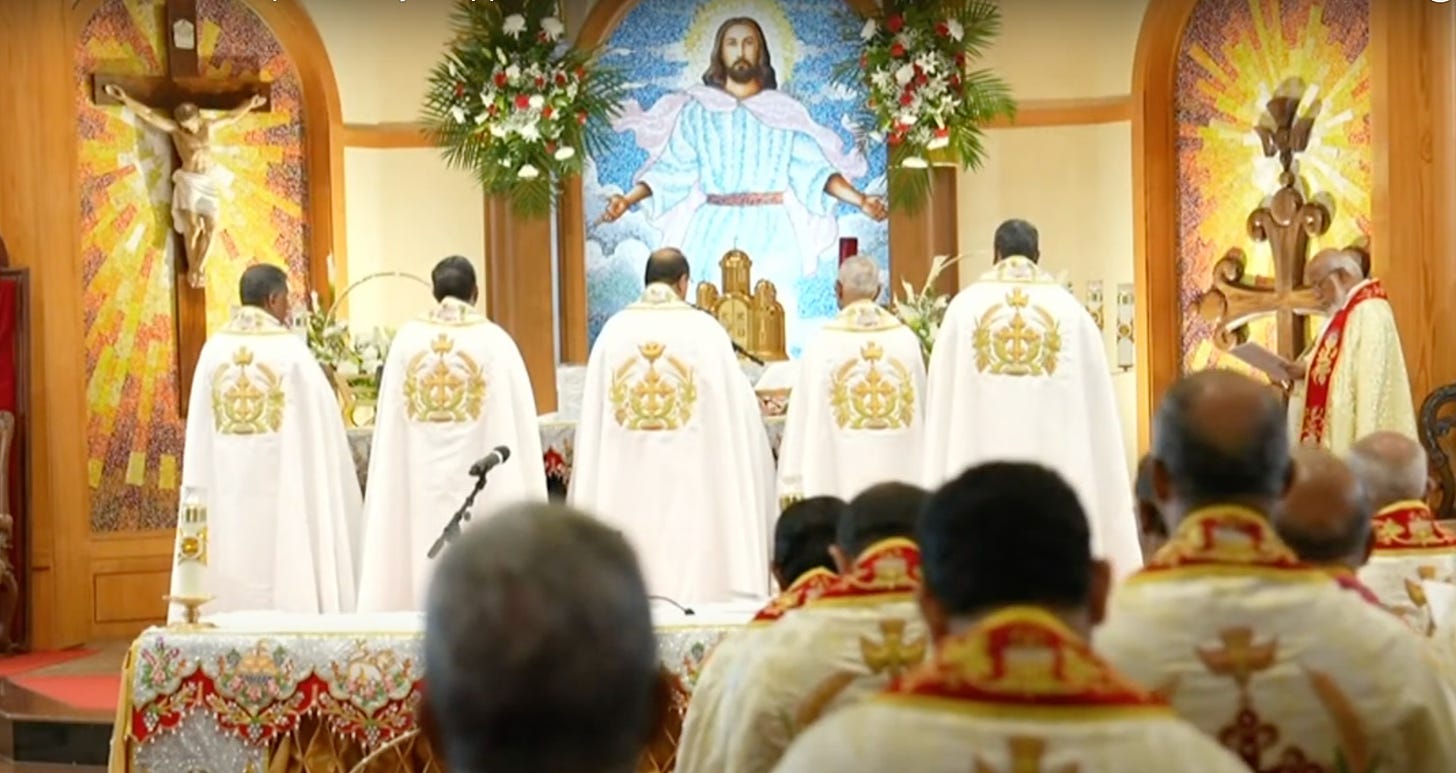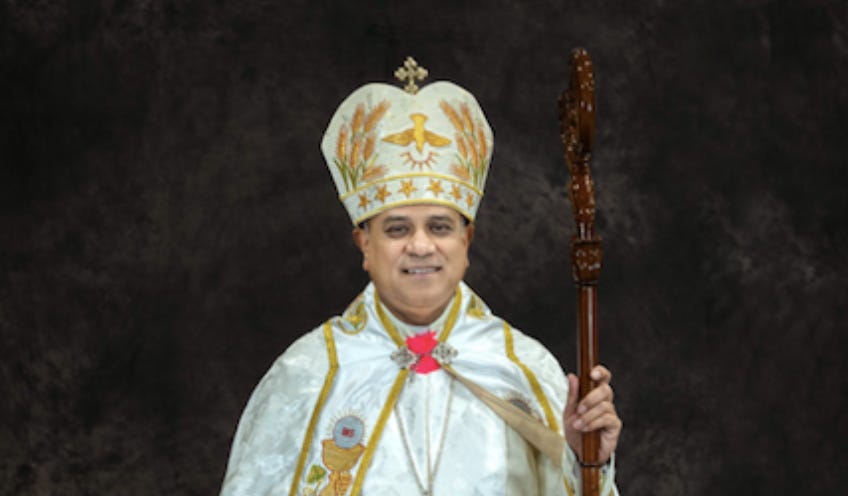When tens of thousands of Catholics gather in Indianapolis this month for the Church’s Eucharistic Congress, they will be invited to a liturgy that most have never experienced before.
The Holy Qurbana, the Eucharistic liturgy of the Syro-Malabar Catholic Church, will be celebrated in Lucas Oil Stadium July 20, as the day’s main Eucharistic celebration at the Congress.

The Qurbana is an ancient liturgical rite, which began in India, celebrated by Christians who say they were evangelized by St. Thomas the Apostle just decades after Christ rose from the dead.
Bishop Mar Joy Alappatt, who is eparch of the Syro-Malabar Catholic Church in the United States, will celebrate the Holy Qurbana. The assembled congregation is expected to comprise the largest number of U.S. Catholics to attend the Qurbana Eucharistic liturgy in one place — and for many, it will be a new and unique experience.
Bishop Alappatt talked with The Pillar about the liturgy, the Syro-Malabar Church in the U.S., and the challenges facing Christians in India.
This interview has been edited for length and clarity.
Bishop, it is unusual, and perhaps surprising, that the National Eucharistic Congress would feature so prominently the Holy Qurbana, the liturgy of the Syro-Malabar Church, which will be celebrated in Lucas Oil Stadium during the Congress.
How did that come about?
I am very happy that we have been given an opportunity like this.
The Congress leaders wanted an opportunity to introduce at least one of the Eastern Catholic liturgies to the people who will be attending. And at first they approached the Ukrainian Church, but there is some difficultly with how that would work.
[Editors’ note: According to Congress organizers, the logistics of reverently distributing the Eucharist during a Ukrainian Greek Catholic liturgy would likely have proven difficult in a liturgy offered in a stadium.]
After that, I offered during a meeting our Eastern Catholic bishops here in the U.S. — I volunteered.
Please tell our readers something about the history of your Eucharistic liturgy — the Holy Qurbana.
Where does the rite come from?
Our Church originated in India, the southwest tip of India — where there is a beautiful state called Kerala.
And we in Kerala got the Catholic faith from St. Thomas, the apostle of Christ, who came to India in AD 52; because of his mission work, we got Christianity in India.
Qurbana — our Holy Mass — is originated from St. Thomas. And his disciples attended Qurbana, and taught that Qurbana to our community.
And a lot of developments came. In the initial part, we were connected with the Chaldean Church, at the present time in Syria and Iraq. And after preaching the Gospel there — in the Chaldean region — St. Thomas traveled to India and landed in Kerala. Because of his affinity toward the local people, he converted a lot of people to Christianity — and Christianity developed there, mostly in the southern region.
There was also a migration of people from Syria to India, and when those migrants came to India, they brought their Christian faith also.
Bishop, most Latin Catholics have not been to any Eastern liturgy, let alone Holy Qurbana.
What should Catholics expect who will attend the Eucharistic Congress?
Our liturgy has three forms. The first is called the Rasa Qurbana — it is the most solemn form of the celebrating the liturgy. It takes a long time, there are a lot of prayers and chant, and some extra readings — we use this form only seldom, on solemn occasions.
The second form is the solemn form: We use it for feast days and Sundays — obligatory days. We will use this form at the Eucharistic Congress.
On ferial days — weekdays — we use the simple form, which is the shorter one.
In the solemn form there are psalms, readings, regular hymns, preaching, and the creed — things that will be familiar, much of it.
What will Catholics notice that is distinctive about the Qurbana?
For this Qurbana, we have two parts.
In the first part, we face the people and we start Qurbana, inviting people to join in this Qurbana, as our Lord commanded on the Passover day. There is an invitation hymn for the people to come and join.
With that hymn, the Qurbana starts. Then we continue with the Incarnation hymn — glory to God in the Highest. Then the Our Father prayer, then we come to the Psalms, and begin to celebrate the Word of God.
Before we come to Word of God, there will be praising of God — there is a beautiful prayer at that point: “You are holy, Lord, holy God. Holy mighty one, holy immortal one, have mercy on us.”
And after the Word of God, we have the homily, and the offertory from both sides of the altar.
One aspect of the Syro-Malabar liturgy is that we cover the bread and wine with a linen cloth, there is a mystery aspect to this: We will expose it when we say the words of consecration: it will be exposed, and then shown to the people.
And this conveys God’s magnificent and transcendent glory, which we are not able to see by our naked eyes — so it’s distinct from us. The altar section of the Church we consider as heaven. In the Old Testament, Moses covered his face, he could not see the face of God, because God’s glory was so high, so he was not able to stand before him.
In this second part of the liturgy— after the homily and creed, for the anaphora, or Eucharistic prayers, we face the altar, and thus we are facing the east. We face the altar, and we break the body and blood of Jesus.
We all agree with the synodal form, and we follow what the synod says.
So we face the east, we are looking to Jesus, to the second coming of Christ, and we are joined with the heavenly host — that is our concept, and why we are facing the east.
What can you tell me about the spirituality of the Syro-Malabar Church?
We follow the spirituality of St. Thomas who brought the liturgy to us, and we express our faith through different spiritual discipline.
First, I would say that we follow several other times of fasting, other than those of the Latin Church.
We have 25 days of fasting before Christmas. We observe 50 days of fasting before Easter — the whole Lent season is fasting season, which begins on a Monday, rather than on Ash Wednesday.
Then we have another period of fasting in preparation for the birth of the Mother of God on September 8 — the first of September through the feast, we observe days of fasting, for the Blessed Mother.
For the feast of the Assumption, there is 15 days of faith, before Mother Mary’s Assumption.
Then in March, we have three days of fasting like Jonah, who spent three days in the belly — we observe three days of fasting like Jonah.
These are all optional periods of fasting, with abstaining from meat and from favorite foods.
Tell me about your eparchy, the Eparchy of St. Thomas of Chicago, which covers the entire United States.
Our diocese was pronounced — established by Pope John Paul II on March 13, 2001, and inaugurated on July 1, 2001.
We are almost 100,000 Catholics, although we don’t have detailed statistics.
We have 68 priests working for this diocese — most of the priests, and even myself and the former bishop — we all came from India. But within these years, we have had seven youth who are from the U.S., born in America, who have been ordained here in America.
There are nine students now in the seminary — we do not have a seminary for our own, so we are sending them to nearby Latin seminaries, like Mundelein, St. John Vianney in Minneapolis, sometimes we send to Rome.
We sometimes have tensions between those who came from India and those who are born and brought up here in America — as any other immigrant community faces, the same situation. Once people grow up here, there can be changes in the values, in their practices, and in their faith life.
But we try to teach our youth our traditional observances and our spiritual disciplines — and many of them are following their parents. We can not expect 100% return among our youngsters, but many of them remain with us.
Our Church is growing here in America and it’s growing steadily — now we have 52 parishes and 34 missions, spread all over America. And you are always welcome to come to the liturgy, people are always welcome to come, wherever they live.
Bishop, can you speak about the persecution which Christians are now facing in India?
Yes, this is a very risky time for us now, especially in the Manipur state. There are a lot of problems in the north, and our government, the BJP Modi government is a little fanatic.
We have found ways to help, especially through the USCCB.
Bishop, at the Eucharistic Congress, tell me — will the liturgy be spoken or chanted?
Both. There are several hymns of the priest, included in the liturgy, and also there is reciting of some prayers.
Have you celebrated a liturgy in front of so many people before?
Not in America, no. We have never celebrated our liturgy in America in such a big place like this Eucharistic Congress, never before.
And the Latin Catholic priests can join us as concelebrants, vested in their own Latin vestments, for this Holy Qurbana, and I expect that more than 100 bishops will come as well.




